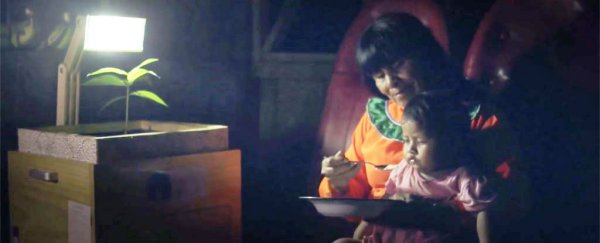In parts of the world that don't have steady access to the electricity grid, finding power for essential things like night lighting are an ongoing challenge. While you can burn kerosene in lamps to provide illumination, the unhealthy smoke and fumes make it a far from ideal solution.
Luckily for the inhabitants of Nuevo Saposoa, a remote native community in Peru, they were chosen to be the recipients of experimental 'plant lamps' (Plantalámpara in Spanish). The lamps run for 2 hours a day and provide bright LED lighting with low power consumption, which in this case is sourced from nutrients in the plant and soil itself.
"We put the plant and soil into a wooden plant pot together with a previously established and properly protected irrigation system," said engineer Elmer Ramirez from Peru's University of Technology and Engineering (UTEC). "Then, inside the pot we place the energy generation system that we created which stores soil and electrodes capable of converting plant nutrients into electric energy."
In conjunction with advertising agency FCB, the researchers developed 10 trial plant lamps and donated them to Nuevo Saposoa's residents. The village, situated in rainforest, is located in Ucayali, a region noted for having Peru's lowest rate of access to electricity.
While the extensive rainforest surroundings are part of what keeps the village separated from the country's electrical infrastructure, the vast amounts of vegetation and flora in the area would also be the perfect resource to build more of the plant lamps, which run on the free electrons of microorganisms released by the plants during their growth.
"We made proper use of the Amazon region's own natural resources such as the soil and plants, in harmony with the environment without any impact whatsoever on the forest," said Ramirez.
In addition to helping people cook food, perform work, and entertain themselves in the evenings when the sun has gone down, the fundamental benefit of Nuevo Saposoa's plant lamps will be in giving the village's children extra hours of the day for reading, writing, and school work. Education in Ucayali is not strong, with less than 30 percent of people attending secondary school and almost 15 percent of the population illiterate.
"While there are shortages of a number of resources in Nuevo Saposoa, the absence of electric energy has a major impact on its social, educational and family development", said Jessica Ruas, a marketing director at UTEC. "We are positive that this will result in a better quality of life for community families because, by using the Plantalámpara, they will have access to renewable energy to provide light to their homes for use by the children during their school work study hours … [and] contribute to the self-sustainability of the population."
You can check out how the plant lamps came to be (and how they operate) in the video below:
